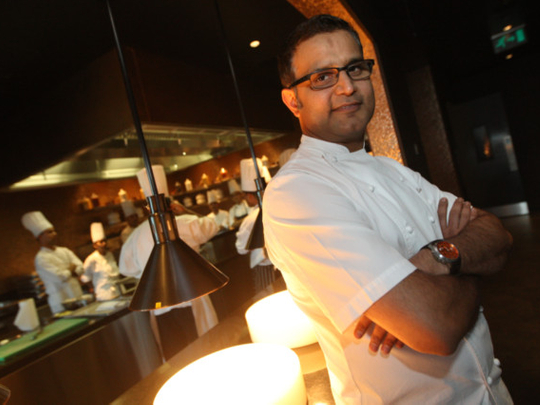
It was a particularly irritating start to the day (don’t get me started about appointments going awry, the heat and waking up on the wrong side of the bed) when I met him last weekend. But his zen-like personality will soothe any soul as would the food he makes.
If you didn’t know what he looked like, meeting him by chance, you wouldn’t realise the man — dressed in a pale blue linen shirt and jeans that seemed effortlessly casual and comfortable in the luxurious surroundings of the JW Marriott Marquis — was not just the first Indian chef to receive the Michelin star but has seven restaurants, including two on board the P&O Cruise ships Azura and Ventura.
“My mother was my encouragement, but my father was my inspiration,” said Chef Atul Kochhar, who turns 44 on Saturday. The twice Michelin-starred chef grew up in Jamshedpur, Bihar (now Jharkand) and comes from a foodie family — his father was in the catering business and his grandfather was a baker. “In fact, when I received my first Michelin star, the first person I called was my father and his reaction was ‘great, but ultimately it’s a tyre company’.
“There’s so much I’ve learnt from him. He was the one who made me think and use indigenous produce to create traditional Indian recipes. And that is why I believe I am where I am today”.
Kochhar has been a familiar name on the UAE food scene and loves to be in Dubai.
“I enjoy coming back to Dubai. I’ve been coming to Dubai for the last 10-12 years and I’ve seen it grow. As for food scene, it’s so rich, so vibrant. In fact, if I didn’t have a restaurant here, I’d be very envious. I had the same feeling when I moved to London in the 1990s and the city was going through exactly the same changes [as in Dubai]. I feel I’m reliving that time and I’m really excited about that”.
AWARDS MAKE A DIFFERENCE
They are a sign/seal of quality and approval, both from the Michelin point of view and the public point of view. For the public it’s like, “you know what? Michelin has given a star; it must be something and should be checked out”. From the Michelin perspective, they must have seen some creativity going in, some connection in the food and must have watched that chef for a while for consistency of the food. Then only they would have stepped out and given a Michelin star.
At the same time, I would say to the diner that you should have your own personal view on things as well. Judge the food yourself. I’ve been to a few Michelin-star restaurants myself and I’ve come out wondering, ‘why did I spend that sort of money? What was there for them to get three Michelin stars? Maybe the Michelin inspector saw it and I didn’t. And I’m sure there are people who feel that way about my food too. I have nothing against them. It’s just a personal impression, personal understanding of the cuisine, the dish and what we walk away with because it’s never just about the food. When Michelin comes into play it’s the whole package — the food, service, how the waiter approached, how you were greeted at the door, whether the air went right in your face or was very gentle. So it’s all about comfort and pleasure you feel in your space.
CREATING A SIGNATURE DISH
It’s a personal perspective. A lot of people would go a different way and it’s very easy to sit and criticise. I’m not saying my way of looking at food is 100 per cent right but given the moment, the present circumstances and conditions in terms of technology, equipment and my own knowledge, I feel I’d do the best I can. Can I improve? Yes I can. As far as taking a dish and constructing/deconstructing/reconstructing is concerned every chef has got his personal forte in that. For example, the way I look at Rogan Josh and want to deconstruct it I would be constructing in a different part of the world from where it originated. Sitting in London, I wouldn’t bother taking leg of lamb, I would take rack or rump of lamb — or even saddle of lamb, which happens to be the most tender cut of the meat — and it will be more appreciated because the people have more understanding of that part of meat. But in India, or even Arabia, I would go for cuts that are slightly harder and take longer to cook, and I would apply a very gentle cooking method.
Spicing is another personal perspective. Take a chef from Kashmir and you should have saffron and almonds. If there’s one from Chennai, kalpasi (black stone flower) is a must-have for garam masala. So, the meaning changes with location.
Dishes are like religious speeches. You say one line and everybody perceives a different meaning. My menu may be exactly like another chef in town, say Sanjeev Kapoor or Vineet Bhatia, but we’ll have our own ways of looking at it.
FOOD IS LIKE FASHION
India is such a large country, from north to south, east to west, it’s difficult to say what’s authentic, although everything is traditional Indian food. Food is like fashion. In January you’d like to wear stripes but come March, fashion has changed and you have to wear a plain shirt. Food is pretty much like that. Food is ever-evolving. Certain ethos remain same, certain ingredients remain same. But it’s how you evolve the dishes is something totally different. Chefs are like fashion designers, they have their own perception of food and that’s how I see food. It’s my experience.
NOTICEABLE IN ABSENCE
Not being in India, for me, at the moment is a choice. I’ve spread myself quite wide. I have three restaurants on ships, one in Dubai, one in Mauritius, three in Europe. India is the only place I go back and find my sanity. I’ve nothing to do, I can put my feet up and relax. So, I’m not in any hurry to look for anything there. Yes, there are opportunities, there are people constantly asking. Not that I don’t want to but I just feel that there’s a lot happening in India at the moment and I’d like things to settle a bit before I make sense out of it. And the way I see myself progressing from here is rather than creating business — which I would like to, no doubt about it — creating an educational environment.
INDIA NOT READY TO ACCEPT MODERN INDIAN CUISINE
India is a large country and yes there’s a group of people who are, unfortunately, looking up more to Masterchef Australia than Masterchef India. But they are getting inspired and want to learn foreign cuisines and other ingredients, which are available within the country as well.
There are a lot of kids coming out of catering colleges and thinking “you know what? I don’t have to go the traditional route and just work under someone in a hotel. I can try and open a nice café. There are a lot of 9-6 workers and I can give them great quality food around their work place”. India will change in those aspects and while those changes are happening, we are going through a severe shortage of workforce. Some blame lies with us — people like me and Sanjeev Kapoor and others — we gave them wings and showed them you can work abroad and on cruise liners and what not.
But, at the same time, people who are in training now are always in a hurry. When I trained in India, I didn’t have to hurry in anything. I took my time. A skill was acquired, a box was ticked on and I moved on to the next level. Everything has become time-bound, which saddens me a bit. People say I’ve done three years of x, y, z. Yes, but do you have good knife skills? Do you understand your ingredients? Do you understand the spices and how to mix them? Do you know what to buy in the market? When you land in the market, do you know what fish you are buying? Which part of the animal you are taking for which dish? I mean, all those things have gone for a six at the moment and it’s really sad because that’s where the building blocks lie. People need to actually take a step back and look at that part and then come back to say, “yes, we are going to reinforce this cuisine once again”.
MEDIA’S ROLE
When I went to UK, Indian food was still a curry house. Today there are curry houses and Indian restaurants. We have elevated to that level and without media’s help I don’t think it would have been possible. The way Michelin was publicised, the way the immigrant chefs were portrayed. All that stuff which has happened over a very long time for us — it has taken us 20 years to change the image of Indian food abroad — and now Indian hoteliers are asking us to open a space which was a complete no-no because they had their five restaurants of different cuisine and of course they thought they were the leaders of the cuisine and knew what to do. But now they are accepting the fact that their forte is to sell rooms and that they can get someone else who actually knows a cuisine very well and does it passionately for a living rather than just have a restaurant. And it’s all down to media to elevate us to that level and I hope most of us will be able to deliver to the society for putting us on that pedestal.
WHAT LIES AHEAD
I wish I could say I’d lie low and not do much. But the truth is there’s a lot happening and whatever I have on my plate, I want to execute it really well. A Few things have happened fairly quickly and I’m just taking a step back and consolidating and strengthening the whole thing. I opened Rang Mahal last November and there’s a lot to be done. We are in a good space. We’ve got good reviews in a short time, and I’m really grateful for that. What we’ve done of the moment is just put our toe in the water to check and now it feels to be home to be honest.
ATUL KOCHHAR’S MOST IMPORTANT TOOL
Wok or kadhai. It’s traditional and there’s a lot of flavour-building going on there. It’s a very versatile utensil that can be used in different ways.











